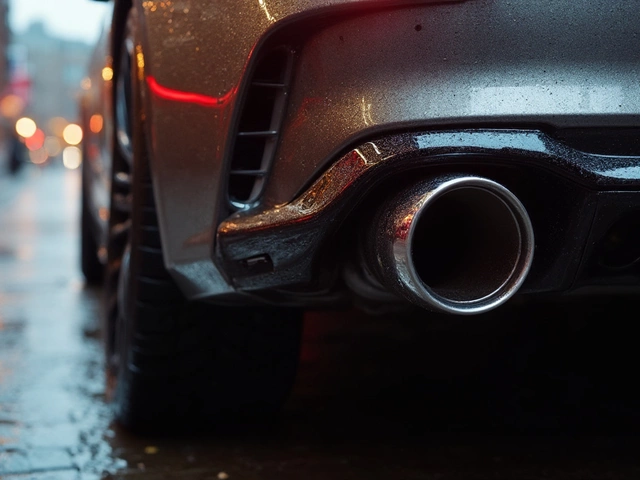“My car sounds boring.” That's a complaint you hear a lot. Some drivers want snarls and growls, not the muted hum factory exhausts deliver. Chasing that perfect exhaust note usually leads to talk about a resonator delete—but does hacking that part out really change things as much as people say? More importantly, is it worth the hype, or just a ticket magnet in disguise?
What a Resonator Actually Does
To understand what resonator delete means, you need to know what a resonator does in the first place. Sticking right after your catalytic converter and before your muffler, a resonator’s job is to fine-tune the sound coming out your tailpipe. Think of it as a second editor, taking the engine’s raw sound waves, canceling out some of the higher-pitch droning that would drive you nuts, and giving it a more controlled, refined tone. It's all about air pulses and acoustic science—there’s even a bit of math behind the resonator’s shape, length, and materials.
Here’s a fun fact you may not expect: Some automakers specifically tune their resonators for their market. For example, the Honda Accord sold in North America can have a different resonator size than the same model in Japan, just because Americans generally prefer a different exhaust tone.
Resonators don’t “block” or slow exhaust gases, but instead manage airflow and cancel out sounds at certain frequencies—usually those that cause an annoying drone on the highway. Without a resonator, many cars and trucks get louder, but also boomier. The difference is easy to hear if you drive a sedan on a long road trip. That smooth, almost whisper-quiet hum you hear at 65 mph? Thank your resonator.
Now, if you inspect an aftermarket exhaust, you might notice they often ditch the resonator entirely, or swap in a straight pipe. This change is usually made to increase engine sound, not power. Let’s bust a myth here: the resonator itself rarely creates a real restriction, especially on modern performance cars with free-flowing stock exhaust systems. So if you're after raw horsepower, removing the resonator by itself usually has a minimal effect—often less than 2-3 HP, which you probably won’t feel unless you’re measuring with sensitive equipment like a dyno.
A Deep Dive Into Resonator Deletes: What Happens When You Remove It?
So, what happens if you chop your resonator out and replace it with a straight pipe? Instantly, things get louder. On most engines, the first thing you’ll notice is a more aggressive note on throttle, and a sharper, even raspy sound at higher RPMs. Acceleration may sound deeper, but on a long highway cruise, get ready for a drone that wasn’t there before. Some people dig it. Others hate it and can’t get the stock part back fast enough.
If you drive a sporty car—a Mustang GT, a BMW 3-Series, or a WRX—removing the resonator often makes the car sound racier and louder under acceleration. Fans love the pop and burble on overrun. But even daily drivers and trucks see a big shift. Take a 2020 Honda Civic, for example. A resonator delete gives it a much bigger bark, but also, depending on your ears, a slight tinniness when you let off the gas.
The evolution in sound isn’t always a one-way win, though. Let’s put it this way: If you usually haul kids, friends, or in-laws, their patience might run short on anything longer than a coffee run. You’ll also start to notice more vibrations in the cabin, especially if you already have other exhaust mods. Some budget sedans develop a deep, headache-inducing drone around 2,000 RPM—that’s the downside to just hacking out a tuned part without any real sound planning.
Now, here’s the kicker. If your car is turbocharged and you’re running a full custom exhaust system, sometimes a resonator delete paired with a performance downpipe and high-flow muffler can (in rare cases) rob you of low-end torque or cause unwanted turbulence. Properly tuned systems deal with that, but slapdash backyard jobs run the risk.
Let’s throw down some numbers. According to a 2023 comparison by MotorTrend, a stock 2021 Ford Mustang GT picked up only 1.8 horsepower at the wheels post-resonator delete. However, owners reported the car “sounded twice as loud”—especially on cold starts and full-throttle runs.

Pros and Cons: Should You Delete Your Resonator?
Before making any cuts, weigh the real upsides and the real headaches. Sure, a resonator delete is cheaper than most exhaust mods and can be done in an hour. The price for a typical job at a local shop will hover between $80 and $200, depending on location and materials. DIYers can grab a straight pipe and clamps for as little as $35—but you’ll need to cut and weld for a clean fit.
But you’re not just trading quiet for muscle-car vibes. Here’s a breakdown:
- Louder, More Aggressive Sound: Your engine finally sounds alive, especially if you find stock exhausts dull. If you love burnouts and loud revs, you’ll probably love it.
- Minimal Power Gain: Don’t expect magic. You might see a slight edge—about 1-3 horsepower tops on most naturally-aspirated engines. Forced-induction engines (like turbos) could see slightly more, but not night and day different.
- Drone and Vibration: At highway speed, especially in 4-cylinder and V6 engines, the drone increases. Some cars become tiring to drive on long trips—especially if you add other exhaust mods like a muffler delete.
- Emission Laws and Inspections: Some states consider removing any part of the factory exhaust tampering, even if you still have your catalytic converter and muffler. California, for example, has strict noise ordinances. You risk not passing inspection or landing a ticket for “excessive noise.”
- Potential for Raspy Sound: Some cars sound sharp and tinny—think a weed-whacker starting up—instead of deep and throaty, when the resonator goes.
- No Engine Damage: The good news: a resonator delete won’t harm your engine, won’t void your engine warranty (outside of exhaust coverage), and doesn’t increase the risk of backfires if your ECU is tuned properly. If your check engine light comes on, it’s usually from a loose connection, not the lack of a resonator.
One more thing: noises inside the car also go up. You’re not just entertaining people outside—the sound level in your cabin can jump by about 2-5 dB depending on vehicle and road speed, according to data from Jalopnik’s 2022 exhaust test. That can make phone calls and music harder to enjoy at cruising speed.
Got kids in car seats? Maybe think twice. Love thrilling sounds and don’t mind a bit of noise? For you, it’s pure ear candy.
Facts, Figures, and Real-World Tips for Resonator Deletes
Let’s make this really actionable. Not only do resonator deletes have a solid following in car enthusiast circles, but you’ll find all sorts of creative mods posted on YouTube, TikTok, and forums. But the smartest modders do their homework before grabbing a saw.
- Legal check first: Look up your local noise ordinances and emissions inspection rules. Some cities (like New York or Los Angeles) issue automatic tickets for cars above 95 dB, and police often use decibel meters at random stops.
- Listen before you cut: Search for videos of your exact make/model with a resonator delete. The same mod sounds wildly different on a V8 F-150 versus a four-banger Camry.
- Pair mods carefully: A resonator delete with a stock muffler sounds very different than one with a muffler delete or aftermarket system. Go step-by-step if you want the sound but not the drone.
- Know the resale risk: Some buyers run from cars with chopped exhausts. If you plan to sell or trade in soon, keep the old parts—or look for bolt-on solutions.
For those who care about the stats, here's a quick look at how a resonator delete compares with other popular exhaust mods:
| Exhaust Mod | Expected Power Gain (HP) | Noise Increase (dB) | Cost Range (USD) |
|---|---|---|---|
| Resonator Delete | 1 - 3 | +2 - 7 | $80 - $200 |
| Muffler Delete | 1 - 4 | +5 - 11 | $80 - $250 |
| Aftermarket Catback | 3 - 8 | +7 - 12 | $350 - $2,000 |
| High-Flow Downpipe | 8 - 20 (turbo engines) | +8 - 13 | $200 - $700 |
If you’re after pure power, a resonator delete alone probably won’t cut it. The real benefit is sound and, to a lesser degree, a lighter exhaust system (shaving off up to 10 pounds in heavier vehicles). For best results, think of it as one step in a larger plan—maybe combined with a tune, intake, or less-restrictive muffler.
One last tip: Resist the urge to do a cheap, hack-job delete. Leaky or poorly-welded pipes can trigger check engine lights, let exhaust fumes into the cabin, and ruin the sound. Always have a pro do the welding, or use a quality pipe kit meant for your car.
So, a resonator delete? It’s not just for the loud crowd—it’s for anyone who wants a taste of the raw side of their car’s character. But know what you’re getting, and weigh the trade-offs before you start cutting.




